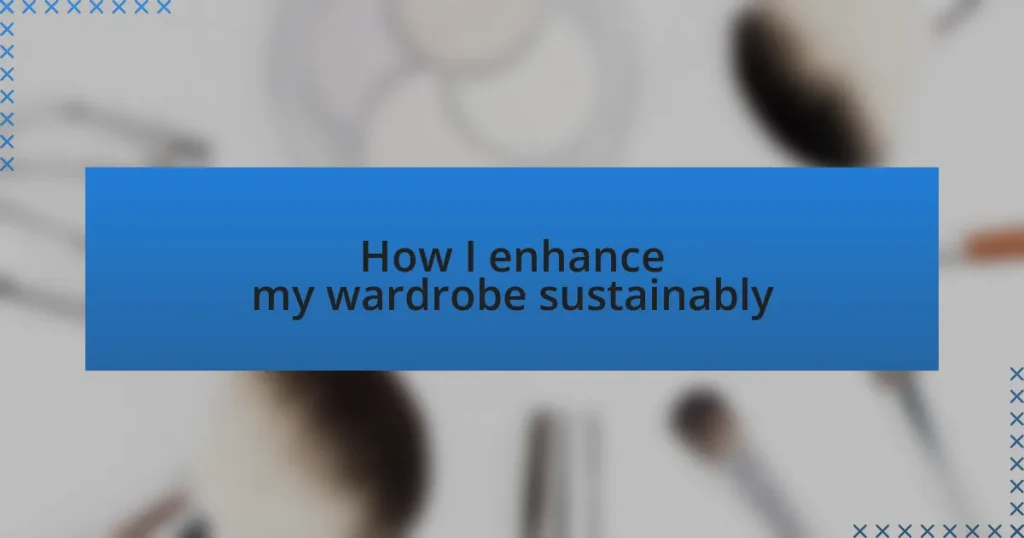Key takeaways:
- Sustainable fashion emphasizes ethical practices and environmental responsibility, encouraging mindful purchasing and reducing waste.
- Key principles include conscious consumption, prioritizing quality over quantity, and embracing second-hand shopping for unique and meaningful pieces.
- Brands like Everlane, Reformation, and Patagonia exemplify transparency, eco-friendliness, and commitment to reducing waste in the fashion industry.
- Secondhand shopping not only offers unique finds but also promotes sustainability and a deeper connection to personal style and values.
Author: Charlotte Hawthorne
Bio: Charlotte Hawthorne is an acclaimed author known for her compelling storytelling and richly drawn characters. With a passion for exploring the complexities of human relationships, her novels often blend elements of romance, intrigue, and self-discovery. A graduate of the University of California, Charlotte has received multiple awards for her work, including the prestigious Silver Quill Award. When she’s not writing, she enjoys hiking in the Sierra Nevada mountains and sipping coffee at local cafes. Charlotte currently resides in San Francisco with her rescue dog, Jasper.
Understanding sustainable fashion
Sustainable fashion is more than just a trend; it’s a mindset that prioritizes ethical practices and environmental stewardship. I remember the first time I learned about the impact of fast fashion. It was eye-opening to realize how much waste and pollution are generated by our clothing choices. Have you ever thought about where your clothes end up once you no longer wear them?
Each piece of clothing carries a story, from the resources used to create it to the hands that made it. I often reflect on the connections between my wardrobe choices and the lives of those involved in the production process. When I consciously opt for brands that prioritize sustainability, I feel a sense of empowerment. Doesn’t it feel good to know your clothing reflects your values?
The beauty of sustainable fashion lies in its diversity; it encompasses everything from thrifting to supporting local artisans. My experience with thrift shopping has been particularly rewarding. Not only do I find unique pieces, but each item is a small step towards reducing my carbon footprint. Isn’t it fascinating how one wardrobe choice can create ripples of positive change?
Benefits of sustainable wardrobe
One of the key benefits of a sustainable wardrobe is the reduction of environmental impact. When I began choosing eco-friendly fabrics and thrifting, I noticed how my purchases contributed to less waste. Have you ever stopped to think about how much landfill space is filled with discarded clothing? Each outfit I wear now feels like a step toward protecting our planet rather than contributing to its problems.
Sustainable fashion also encourages creativity and self-expression. By mixing and matching pieces in my closet, I’ve developed a unique style that reflects who I am, rather than what’s trending. It’s liberating to step away from the constant chase for the latest styles. How often have you found yourself buying clothes just because they were popular, rather than because you truly loved them?
Finally, embracing a sustainable wardrobe fosters a deeper connection to the pieces I own. Each item feels special, and I often find myself reminiscing about where I bought it or the stories behind it. The emotional value of clothing can truly enhance the experience of getting dressed each day. Isn’t it amazing how a simple shift in our approach to fashion can transform our relationship with our wardrobe?
Key principles of wardrobe sustainability
One key principle of wardrobe sustainability is the concept of conscious consumption. I always ask myself before a purchase, “Will I wear this item multiple times?” This simple question has saved me from making impulsive buys that would only contribute to clutter in my closet. I’ve found that when I approach shopping with intention, I end up selecting pieces that genuinely resonate with my lifestyle and aesthetics. Isn’t it satisfying to wear something that feels both right and practical?
Another vital aspect is prioritizing quality over quantity. I’ve learned from experience that investing in well-made garments pays off. A high-quality item lasts longer and often looks better, ultimately reducing the need for frequent replacements. Recently, I splurged on a tailored jacket that has become a staple in my wardrobe. It’s versatile, durable, and a reminder of the value of choosing fewer, but better pieces. How often do we get caught up in buying cheap, trendy items that need to be tossed after just a few washes?
Lastly, embracing second-hand shopping has been a game changer for me. Not only does it minimize waste, but it allows me to discover unique items with history. One of my favorite finds was a vintage dress that came with a handwritten note from the previous owner, sharing its story. It felt like I was giving a new life to something that still held sentimental value. Have you ever considered how much treasure lies waiting in thrift stores? It’s a sustainable choice that not only saves money but also adds character to my wardrobe.
My favorite sustainable fashion brands
One of my all-time favorite sustainable fashion brands is Everlane. I love how they prioritize transparency in their production processes, sharing details about their factories and the costs behind each item. Every time I slip on one of their basic tees, I appreciate knowing that its quality comes from a mindful creation journey. Have you ever worn a piece of clothing that felt like it was made just for you, with an honest story behind it?
Another brand I admire is Reformation. Their commitment to eco-friendly materials and practices resonates with my values. I recently wore a stunning floral dress from them to a friend’s garden party, and it felt like a perfect blend of style and sustainability. It made me wonder: how many compliments can one sustainable piece garner while helping the planet? Every time I don that dress, I feel inspired to make choices that give back to the Earth.
Lastly, I cannot overlook Patagonia’s incredible work in promoting environmental protection through fashion. Their focus on repairing and recycling their clothing aligns perfectly with my belief in reducing waste. I once participated in one of their Worn Wear events, where I exchanged an old jacket for store credit. This experience gave me not just a new piece but a deeper appreciation for the circular economy in fashion. Have you ever felt that satisfaction in knowing that your wardrobe choices contribute to a healthier planet?
How I shop secondhand
When I first started shopping secondhand, I felt a mix of excitement and uncertainty. Stepping into a thrift store is like entering a treasure trove where each rack holds the potential for a unique find. Last summer, I stumbled upon a vintage leather jacket that, even though it had its fair share of wear, felt like it had stories to tell. Do you ever wonder about the adventures that a good piece of clothing has been through?
I also love browsing online marketplaces where I can sift through a plethora of options from the comfort of my home. Finding high-quality brands at a fraction of the retail price feels like a small victory. Just the other week, I scored a pair of barely used designer shoes that complemented an outfit I had been looking forward to wearing. Can you remember the thrill of scoring an unexpected deal that makes you feel like you’ve outsmarted the fashion system?
Another aspect I cherish about secondhand shopping is the element of sustainability behind my choices. Each piece I bring into my wardrobe not only cuts down on waste but also supports a more mindful approach to fashion consumption. Recently, after purchasing a beautiful vintage dress, I felt a strong connection to my own style and values. Have you felt the joy of adding something to your closet that reflects both your personal taste and your commitment to the planet?


